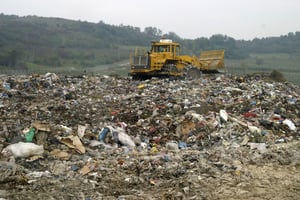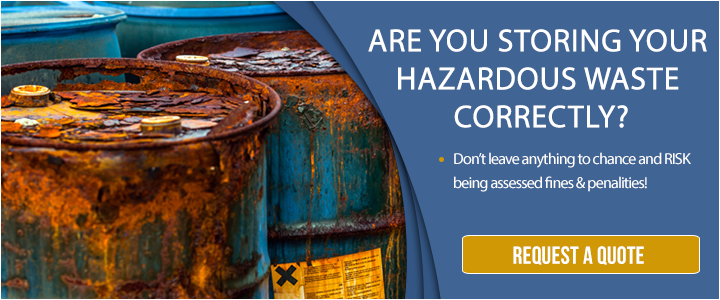While five-gallon buckets with giant radiation symbols are a mainstay of cartoons and comedy, they’re not nearly as funny in real life.
Imagine, if you will, opening a storage locker or closet and finding a container emblazoned with a biohazard sign, the skull and crossbones, or an exploding bomb – but otherwise unlabeled. What on Earth are you supposed to do with that? Literally, where on Earth would such a container be safe?
It’s hard to tell, which is why it’s so important to know the rules regarding the proper handling and storage of hazardous waste. That pertains both to waste you’re dealing with now and waste you can’t identify that might crop up in a disused building or corner of a facility.
Let’s take a brief look at the responsibility of hazardous waste generators, talk about proper labeling and troubleshoot what to do with unidentified waste. By the end of this post, you’ll be much better prepared to deal with environmentally damaging and potentially lethal waste, so don’t wait.
With Great Hazardous Waste Comes Great Responsibility
Spiderman’s uncle said it best when he said, “With great power comes great responsibility.” In this case, the power is to destroy, which makes it even more important that you do your duty when it comes to toxic, explosive, corrosive, flammable or contagious substances. 
Many businesses in Los Angeles and the surrounding areas produce hazardous waste. These materials generally exhibit levels of toxicity, flammability, corrosivity or chemical instability above standard safety levels, and can include items such as:
- Heavy metals
- Radioactive compounds
- Pesticides
- Biohazardous waste
- Oil, paint and household cleaners
Unfortunately, improper handling of toxic waste can release harmful chemicals into the air, ground water or soil, posing a serious threat to both the environment and any surrounding residences. In order to abide by regulations set forth by various federal and state agencies, including the U.S. EPA and California Department of Toxic Substance Control, hiring a reputable waste removal service is essential for safely and legally disposing of hazardous materials.
Of course, hiring another body doesn’t relieve you of the responsibility to label of hazardous waste correctly. When you neglect to provide clear labels, you make the job of the waste removal company that much harder, and increase the chances of a mishap.
Clear labeling is therefore crucial to the proper handling and storage of hazardous waste.
The Eleventh Commandment: Thou Shalt Label Containers Clearly and Properly
More happened at Mount Sinai than you might think. Burning bush, voice from heaven, clear instructions regarding the classification of hazardous waste, yada yada.
Okay, so that’s maybe not quite accurate. We wish it were, though, because despite very clear instructions on the labeling of hazardous waste containers from organizations such as California’s Department of Toxic Substances Control and equivalent bodies in other states, many companies fail to get this right.
Proper waste management protocols and proper hazardous waste labels vary depending on the hazardous waste classifications of different substances and any relevant municipal, state, and federal laws. Oftentimes, corrosive, unstable, or especially volatile materials will produce dangerous reactions if combined with another substance or placed within the wrong type of container.
That’s why its so important to know the storage and handling requirements for each type of hazardous waste, then to notate contents carefully. That includes:
- Date accumulation begins (which may need to be changed if you add older waste to a newer container)
- “Recurring use” or “daily use” labels to indicate containers used more than once or on an ongoing basis
- The words “hazardous waste” clearly displayed
- Composition or physical state of the waste, and a notation of the exact danger of the waste (flammable, toxic, etc)
- Name and address of waste generator
Sometimes, however, that information just isn’t provided.
The Quick-Start Troubleshooting Guide to Unidentified Waste
Let’s return to our hypothetical (but all too common) situation whereupon you stumble across hazardous waste in a disused storage room, locker, basement, yard or defunct building. If even the mere thought causes you some anxiety, well, it should. So congratulations, your lizard brain is working well.
The first step is to do some research within the company and try to get more details. Do any other workers, managers or stakeholders know what it can be? Do you have access to records you can check? Can you cross-reference any details of the “crime scene” to come up with more information? This will not only give you the best chance of dealing with the situation right, it can be helpful to your waste management company.
If you truly have no idea what the container is, it’s time to perform some screening tests. That may mean calling your nearby health authority or toxic substances body, or if you have the equipment and facilities, you can perform a quick screen yourself. That includes testing for:
- Air reactivity
- Water reactivity
- Corrosivity
- Flammability
If you don’t have the ability to do such tests, don’t. If you are able to, take that data and compare it to your state’s regulations to figure out what to do next. If you do not already have rules and regulations in place to test waste – ones that align with state and federal statutes – do not proceed.
Without the proper resources and skills to safely assess, handle, and transport these materials, your business runs the risk of exposing itself to a toxic spill, endangering the lives of others, and increasing your liability for any harmful effects, so call a waste disposal company right away instead.
Depending on the scope and diversity of your company, it is entirely possible that you produce more than one type of hazardous waste, or even non-hazardous waste with special disposal requirements. Finding a reliable waste management company can help you address all of your sanitation and disposal needs safely, efficiently, and legally. That way, you can check off worry and institute reliability day in and day out.


Comment